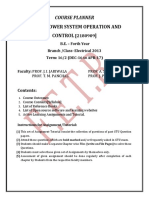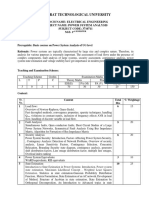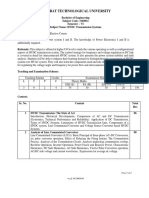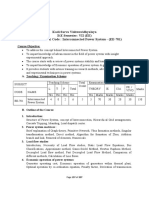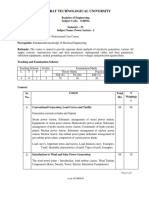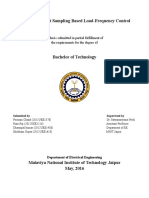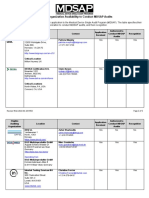Powwer System Operation and Control PDF
Powwer System Operation and Control PDF
Uploaded by
mitulCopyright:
Available Formats
Powwer System Operation and Control PDF
Powwer System Operation and Control PDF
Uploaded by
mitulOriginal Title
Copyright
Available Formats
Share this document
Did you find this document useful?
Is this content inappropriate?
Copyright:
Available Formats
Powwer System Operation and Control PDF
Powwer System Operation and Control PDF
Uploaded by
mitulCopyright:
Available Formats
GUJARAT TECHNOLOGICAL UNIVERSITY
ELECTRICAL & ELECTRONICAL ENGINEERING
POWER SYSTEM OPERATION AND CONTROL
SUBJECT CODE: 2180909
B.E. 8th SEMESTER
Type of course: Engineering Science (Electrical)
Prerequisite: Basic understanding of structure of the power system and power system analysis.
Rationale: Demand of electrical energy is increasing day by day due to improvement in the life style of
the people in particular and development of the countries in general. On the other hand, conventional
sources of power generation are limited. Under this scenario, the power system network operates in a
stressed condition. Effective management of generation, transmission and distribution of electrical
power is necessary for optimal system operation, for loss minimization and to avoid the unwanted
power cuts. This subject deals with the fundamentals for effective operation and control of the power
system.
Teaching and Examination Scheme:
Teaching Scheme Credits Examination Marks Total
L T P C Theory Marks Practical Marks Marks
ESE PA (M) ESE (V) PA (I)
(E) PA ALA ESE OEP
4 0 0 4 70 20 10 0 0 0 100
Content:
Sr. Content Total %
No. Hrs Weightage
1. Automatic Generation and Voltage Control: 8 15
Introduction; Load Frequency Control (Single Area Case); Load Frequency
Control and Economic Despatch Control; Two-Area Load Frequency Control;
Optimal (Two-Area) Load Frequency Control; Automatic Voltage Control; Load
Frequency Control with Generation Rate Constraints (GRCs); Speed Governor
Dead-Band and Its Effect on AGC; Digital LF Controllers; Decentralized
Control.
2. Power System Security: 8 15
Introduction; System State Classification; Security Analysis; Contingency
Analysis.
3. Reactive Power and Voltage Control: 12 20 - 25
Introduction; Reactive power requirement of an uncompensated line; Implication
of surge impedance loading; Reactive loss characteristics of transmission line;
Operation of a transmission line at no load condition; Operation of a
transmission line under heavy loading condition; Voltage regulation of the
transmission line and its relation with reactive power; Maximum power transfer
in an uncompensated line; Line loadability.
Reactive power-voltage (Q-V) coupling concept; Governing effects on reactive
power flow; Relation between voltage and reactive power at a node in a power
system; Reactive power requirement for control of voltage in long lines;
Operational aspects in reactive power and voltage control; Basic principle of
system voltage control; Reactive power flow constraints and their implications in
loss of voltage; Effect of transformer tap changing in the post disturbance period;
Effect of generator excitation adjustment in the post disturbance period; Practical
aspects of reactive power flow problems leading to voltage collapse in EHV
lines.
4. State Estimation: 12 20 - 25
Introduction; Least Squares Estimation: The Basic Solution; Static State
Estimation of Power Systems; Tracking State Estimation of Power Systems;
Some Computational Considerations; External System Equivalency; Treatment
of Bad Data; Network Observability and Pseudo-Measurements; Application of
Power System State Estimation
5. Load Forecasting: 8 15
Introduction; Forecasting Methodology; Estimation of Average and Trend
Terms; Estimation of Periodic Components; Estimation of ys(k): Time Series
Approach; Long-Term Load Predictions Using Econometric Models; Reactive
Load Forecasting.
6. Introduction to Power System Deregulation and Restructuring: 8 15
Introduction; Motivation for Restructuring of power system; Electricity market
entities and model; Benefits of Deregulation; Basic terminologies; Deregulation
International scenario; Milestones of deregulation in the world;
Indian power sector Past and present status: Growth of power sector in
India An overview, A time line of the Indian power sector, Players in the
Indian power sector, Research and professional bodies.
Suggested Specification table with Marks (Theory):
Distribution of Theory Marks (%)
R Level U Level A Level N Level E Level Total
15 25 30 15 15 100
Legends: R : Remembrance ; U = Understanding; A = Application; N = Analyze; E = Evaluate
(Revised Blooms Taxonomy)
NOTE : This specification table shall be treated as a general guideline for students and teachers. The actual
distribution of marks in the question paper may vary slightly from above table
Reference Books:
1. Modern Power System Analysis D. P. Kothari, I. J. Nagrath, TMH Publication
2. An introduction to Reactive Power Control and Voltage Stability in Power Transmission Systems
A Chakrabarti, D P Kothari, A K Mukhopadhyay, Abhinandan De, PHI
3. Electrical Power Systems P. Venkatesh, B.V. Manikandan, S.C. Raja, A. Srinivasan, PHI
4. Power System Analysis J. J. Grainger, W.D. Stevenson, Mc-GrawHill series publication
5. Power Generation Operation and Control A. J. Wood, B. F. Woolenberg, John Wiley and Sons
6. Power System Analysis Hadi Saadat, Mc-GrawHill series publication
7. Advanced Power System Analysis and Dynamics L. P. Singh, New Age International
8. Operation of Restructured Power Systems K. Bhattacharya, H. J. Bollen, J. E. Daalder,
Kluwer academic publishers
9. http://nptel.ac.in/courses/108101040/ (PSOC webcourse)
Course Outcome:
After learning the course the students should be able to:
Understand the techniques to control power flows, frequency and voltage.
Explore the significance of power system restructuring.
Perform system state estimation and explore its importance.
Learn the power system security and its application as a system operator.
Carry out load forecasting using available methods.
List of Open Source Software/learning website:
- http://nptel.ac.in/courses/108101040/
- http://www.electrical-engineering-portal.com/
- http://nptel.iitm.ac.in/courses.php
- www.vlab.co.in
ACTIVE LEARNING ASSIGNMENTS: Preparation of power-point slides, which include videos,
animations, pictures, graphics for better understanding theory and practical work The faculty will allocate
chapters/ parts of chapters to groups of students so that the entire syllabus to be covered. The power-point
slides should be put up on the web-site of the College/ Institute, along with the names of the students of the
group, the name of the faculty, Department and College on the first slide. The best three works should be
submitted to GTU.
You might also like
- ISB Cybersecurity For Leaders BrochureDocument22 pagesISB Cybersecurity For Leaders Brochurer.jeyashankar9550No ratings yet
- Eee-Viii-Power System Operation and Control (10ee82) - Notes PDFDocument130 pagesEee-Viii-Power System Operation and Control (10ee82) - Notes PDFKvv Bapiraju81% (21)
- Gujarat Technological UniversityDocument3 pagesGujarat Technological UniversityUmesh RathodNo ratings yet
- Psoc 2180909Document3 pagesPsoc 2180909himanshuNo ratings yet
- PSOCDocument14 pagesPSOCSharmilaNo ratings yet
- Gujarat Technological UniversityDocument2 pagesGujarat Technological UniversityBhavik PrajapatiNo ratings yet
- Power System 1: CO1 CO2 CO3 CO4 CO5 CO6Document2 pagesPower System 1: CO1 CO2 CO3 CO4 CO5 CO6Anonymous HyOfbJ6100% (1)
- 2 FullDocument8 pages2 FullDhaval MerNo ratings yet
- Gujarat Technological University: Application of Power Electronics To Power System M.E. 3 SemesterDocument3 pagesGujarat Technological University: Application of Power Electronics To Power System M.E. 3 SemesterAbhimanyu YadavNo ratings yet
- Current Running SyllabusDocument2 pagesCurrent Running SyllabusAbhimanyu YadavNo ratings yet
- Enhancement of Voltage Profile For IEEE-14 Bus System by Using STATIC-VAR Compensation (SVC) When Subjected To Various Changes in LoadDocument7 pagesEnhancement of Voltage Profile For IEEE-14 Bus System by Using STATIC-VAR Compensation (SVC) When Subjected To Various Changes in LoadbaghdadnethrNo ratings yet
- FPSCDocument15 pagesFPSCBABER SULTANNo ratings yet
- EE6603-SCAD-MSM - by WWW - LearnEngineering.in PDFDocument100 pagesEE6603-SCAD-MSM - by WWW - LearnEngineering.in PDFDhivya BNo ratings yet
- Ee2401 Power System Operation and ControlDocument2 pagesEe2401 Power System Operation and Controlsshivakumar98No ratings yet
- EE2401 POWER SYSTEM OPERATION AND CONTROL Syllabus Regulation 2008Document2 pagesEE2401 POWER SYSTEM OPERATION AND CONTROL Syllabus Regulation 2008Muruga RajNo ratings yet
- Power System Operation & ControlDocument73 pagesPower System Operation & ControlDr. Moh DoshanNo ratings yet
- PSOC Lession PlanDocument7 pagesPSOC Lession PlanskdwarakanathNo ratings yet
- Gujarat Technological University: W.E.F. AY 2018-19Document4 pagesGujarat Technological University: W.E.F. AY 2018-19Darshit KotadiyaNo ratings yet
- IJEDR2004013Document9 pagesIJEDR2004013Hà ĐứcNo ratings yet
- 10ee81 Electrical Design, Estimating and CostingDocument16 pages10ee81 Electrical Design, Estimating and CostingFzs LohiNo ratings yet
- Gujarat Technological University: HVDC Transmission SystemsDocument3 pagesGujarat Technological University: HVDC Transmission SystemsMUMTAZ IMTIAZ SHAIKHNo ratings yet
- PSE PG Structure ModifedDocument61 pagesPSE PG Structure ModifedAnkit YadavNo ratings yet
- 3710713-Power Electronics & ApplicationDocument3 pages3710713-Power Electronics & ApplicationTanvi IsraniNo ratings yet
- Gujarat Technological University: Electrical Power System - I 2150908 B.E. 5 SemesterDocument3 pagesGujarat Technological University: Electrical Power System - I 2150908 B.E. 5 SemesterFaizan HaarisNo ratings yet
- Ee6 (PS2)Document2 pagesEe6 (PS2)vikashkumar1436353No ratings yet
- EE8702 - PSOC Syllabus 2017RDocument2 pagesEE8702 - PSOC Syllabus 2017RRaja Sekar100% (2)
- Power Flow Study On Alternating Current (Ac) Power System: June 2014Document5 pagesPower Flow Study On Alternating Current (Ac) Power System: June 2014Harish PallaNo ratings yet
- Advanced Power System IIDocument2 pagesAdvanced Power System IIdurgesh_ahirNo ratings yet
- Kadi Sarva Vishwavidhyalaya B.E Semester: VII (EE) Subject Name & Code: Interconnected Power System - (EE-701)Document5 pagesKadi Sarva Vishwavidhyalaya B.E Semester: VII (EE) Subject Name & Code: Interconnected Power System - (EE-701)Satyajitsinh ChudasamaNo ratings yet
- Gujarat Technological University: The Wind Power Plant - Introduction, Wind Turbine ClassesDocument5 pagesGujarat Technological University: The Wind Power Plant - Introduction, Wind Turbine Classesjagannathboss10No ratings yet
- Paikray2017 PDFDocument6 pagesPaikray2017 PDFRajveerNo ratings yet
- ETAP Case StudyDocument4 pagesETAP Case Studymithun46No ratings yet
- Review of Load Frequency Control Methods, Part-I: Introduction and Pre-Deregulation ScenarioDocument6 pagesReview of Load Frequency Control Methods, Part-I: Introduction and Pre-Deregulation ScenarioislammuddinNo ratings yet
- Power Quality and FactsDocument3 pagesPower Quality and FactsEle052 Patel MilanNo ratings yet
- Gujarat Technological University: The Wind Power Plant - Introduction, Wind Turbine ClassesDocument5 pagesGujarat Technological University: The Wind Power Plant - Introduction, Wind Turbine ClassesDarshit KotadiyaNo ratings yet
- Control of Photovoltaic Inverters For Transient and Voltage Stability EnhancementDocument12 pagesControl of Photovoltaic Inverters For Transient and Voltage Stability Enhancementsayali kthalkarNo ratings yet
- Muthayammal Engineering College, RASIPURAM 637408 (Autonomous)Document205 pagesMuthayammal Engineering College, RASIPURAM 637408 (Autonomous)Vishal DesignNo ratings yet
- Power Quality FACTsDocument5 pagesPower Quality FACTsshashiNo ratings yet
- PSAT Model-Based Voltage Stability Analysis For The Kano 330KV Transmission LineDocument5 pagesPSAT Model-Based Voltage Stability Analysis For The Kano 330KV Transmission LinesacadNo ratings yet
- B.Tech, EE, 5th Sem, 2018-19 BatchDocument19 pagesB.Tech, EE, 5th Sem, 2018-19 BatchBijayKumarDasNo ratings yet
- EE464 Flexible AC Transmission Systems SyllobusDocument2 pagesEE464 Flexible AC Transmission Systems SyllobussyulmnmdNo ratings yet
- A Sustainable Solar Photovoltaic Energy System Interfaced With Grid Tied Voltage Source Converter For Power Quality ImprovementDocument14 pagesA Sustainable Solar Photovoltaic Energy System Interfaced With Grid Tied Voltage Source Converter For Power Quality ImprovementKrishnaNo ratings yet
- 2 ND Control - of - Photovoltaic - Inverters - For - Transient - and - Voltage - Stability - EnhancementDocument18 pages2 ND Control - of - Photovoltaic - Inverters - For - Transient - and - Voltage - Stability - Enhancementsayali kthalkarNo ratings yet
- Journal-1 (Literature Survey)Document19 pagesJournal-1 (Literature Survey)AjinkyaA.Wankhede100% (1)
- 1 s2.0 S0142061518338122 Main PDFDocument12 pages1 s2.0 S0142061518338122 Main PDFAmit sahaNo ratings yet
- Real Power Loss and Voltage Stability Limit Optimization PDFDocument10 pagesReal Power Loss and Voltage Stability Limit Optimization PDFJEBARAJNo ratings yet
- 10 1016@j Solener 2020 06 085Document23 pages10 1016@j Solener 2020 06 085amina bu bakerNo ratings yet
- Wjaets 2024 0121Document17 pagesWjaets 2024 0121Mohammad Wasib AzimiNo ratings yet
- Chhattisgarh Swami Vivekanand Technical University, Bhilai: Total Period 08Document19 pagesChhattisgarh Swami Vivekanand Technical University, Bhilai: Total Period 08Piyush KumarNo ratings yet
- BE EEE VI Sem MergedDocument12 pagesBE EEE VI Sem MergedNatarajan RajaNo ratings yet
- Influence of Large-Scale PV On Voltage Stability of Sub-Transmission SystemDocument14 pagesInfluence of Large-Scale PV On Voltage Stability of Sub-Transmission SystemokasinskiNo ratings yet
- Application of Model Current Predictive Control in Low Voltage Ride Through of Photovoltaic StationDocument6 pagesApplication of Model Current Predictive Control in Low Voltage Ride Through of Photovoltaic StationVinsen Teubun LetsoinNo ratings yet
- Report Last UpdatedDocument56 pagesReport Last UpdatedSureshChoudharyNo ratings yet
- EE2401Document12 pagesEE2401Ravinder INNo ratings yet
- International Journal of Computational Engineering Research (IJCER)Document9 pagesInternational Journal of Computational Engineering Research (IJCER)International Journal of computational Engineering research (IJCER)No ratings yet
- Bus Bus BusDocument4 pagesBus Bus BusNileshNo ratings yet
- Eet272 Wired CourseDocument10 pagesEet272 Wired CourseJessica RossNo ratings yet
- Power System Operation and ControlDocument175 pagesPower System Operation and Controladam sharma83% (6)
- Tracking Power Photovoltaic System Using Artificial Neural Network Control StrategyDocument10 pagesTracking Power Photovoltaic System Using Artificial Neural Network Control StrategyMohammad Zohaib Khan KambohNo ratings yet
- Eee-Viii-power System Operation and Control (06ee82) - NotesDocument138 pagesEee-Viii-power System Operation and Control (06ee82) - Noteskeerthanavijaya100% (3)
- SLUPPALDocument905 pagesSLUPPALmitulNo ratings yet
- Ece NitttrDocument10 pagesEce NitttrmitulNo ratings yet
- Carunaiselvane, Jeevananthan - 2012 - Generalized Procedure For BLDC Motor Design and Substantiation in MagNet 7.1.1 SoftwareDocument9 pagesCarunaiselvane, Jeevananthan - 2012 - Generalized Procedure For BLDC Motor Design and Substantiation in MagNet 7.1.1 SoftwaremitulNo ratings yet
- Laboratories-List of EquipmentsDocument66 pagesLaboratories-List of EquipmentsmitulNo ratings yet
- Abirami, Bala, Priya - 2014 - Design of BLDC Hub Motor Using FEM AnalysisDocument6 pagesAbirami, Bala, Priya - 2014 - Design of BLDC Hub Motor Using FEM Analysismitul100% (1)
- Selection & Design of BLDC Motor For Different Applications: Priti S. Manware, Md. Bashir Sheikh and M.R. ShelkeDocument6 pagesSelection & Design of BLDC Motor For Different Applications: Priti S. Manware, Md. Bashir Sheikh and M.R. ShelkemitulNo ratings yet
- Tsai Et Al. - 2011 - Model Construction and Verification of A BLDC Motor Using MATLABSIMULINK and FPGA ControlDocument6 pagesTsai Et Al. - 2011 - Model Construction and Verification of A BLDC Motor Using MATLABSIMULINK and FPGA ControlmitulNo ratings yet
- Kim Et Al. - 2003 - Finite-Element Analysis of Brushless DC Motor Considering Freewheeling Diodes and DC Link Voltage RippleDocument3 pagesKim Et Al. - 2003 - Finite-Element Analysis of Brushless DC Motor Considering Freewheeling Diodes and DC Link Voltage RipplemitulNo ratings yet
- Review of Permanent-Magnet Brushless DC Motor Basic Drives Based On Analysis and Simulation StudyDocument29 pagesReview of Permanent-Magnet Brushless DC Motor Basic Drives Based On Analysis and Simulation StudymitulNo ratings yet
- Tayade - 2014 - Modeling and Simulation of A BLDC Motor by Using Matlab Simulation ToolDocument8 pagesTayade - 2014 - Modeling and Simulation of A BLDC Motor by Using Matlab Simulation ToolmitulNo ratings yet
- Improved Analytical Model For Predicting The Magnetic Field Distribution in Brushless Permanent-Magnet MachinesDocument10 pagesImproved Analytical Model For Predicting The Magnetic Field Distribution in Brushless Permanent-Magnet MachinesmitulNo ratings yet
- Noise Source Identification of Small Fan-BLDC Motor System For RefrigeratorsDocument8 pagesNoise Source Identification of Small Fan-BLDC Motor System For RefrigeratorsmitulNo ratings yet
- Commutation-Torque-Ripple Minimization in Direct-Torque-Controlled PM Brushless DC DrivesDocument10 pagesCommutation-Torque-Ripple Minimization in Direct-Torque-Controlled PM Brushless DC DrivesmitulNo ratings yet
- Fuzzyrandomvariables PDFDocument15 pagesFuzzyrandomvariables PDFmitulNo ratings yet
- GEM In-Wheel Drive: Type G1.1Document1 pageGEM In-Wheel Drive: Type G1.1mitulNo ratings yet
- 4S PT2Document3 pages4S PT2Lhevs VillegasNo ratings yet
- pg4 ShureDocument35 pagespg4 Shurejoaquin espalterNo ratings yet
- Calla 1452 Material Safety Data Sheet: Zip-Chem ProductsDocument7 pagesCalla 1452 Material Safety Data Sheet: Zip-Chem ProductsFidel ArellanoNo ratings yet
- Matigo s2 Geog 2022Document12 pagesMatigo s2 Geog 2022ODOKAJE FELIXNo ratings yet
- Productivity Improvement by Using Quality Control Tools - A Case Study of Chartered Rubber ProductsDocument7 pagesProductivity Improvement by Using Quality Control Tools - A Case Study of Chartered Rubber ProductsInternational Organization of Scientific Research (IOSR)No ratings yet
- Brain ExerciseDocument5 pagesBrain ExerciseMuhamad BenyaminNo ratings yet
- API 510 PC 20 31 Aug05 Final Exam OpenDocument4 pagesAPI 510 PC 20 31 Aug05 Final Exam OpennikafiqNo ratings yet
- Module 1 Exam 1.: Periodic TableDocument4 pagesModule 1 Exam 1.: Periodic Tablesophia onu100% (1)
- Lesson 1.4 Domain and Range of Functions PDFDocument36 pagesLesson 1.4 Domain and Range of Functions PDFhi mynameNo ratings yet
- Ujian Tengah Semester (Uts) : ................ Easily. (Win)Document1 pageUjian Tengah Semester (Uts) : ................ Easily. (Win)ari tobNo ratings yet
- Ounting & Maintenance Instructions For Threephase Induction Motors - Types Dm1 / Dma1 / Dma2Document9 pagesOunting & Maintenance Instructions For Threephase Induction Motors - Types Dm1 / Dma1 / Dma2Chad HuntNo ratings yet
- LAB Activity 2:: Letter Binary Representation of The LetterDocument2 pagesLAB Activity 2:: Letter Binary Representation of The LetterDave ValcobaNo ratings yet
- Auditing Organization Availability To Conduct MDSAP AuditsDocument6 pagesAuditing Organization Availability To Conduct MDSAP AuditsteomanNo ratings yet
- Assignment 2 Questions (UGPG) PDFDocument5 pagesAssignment 2 Questions (UGPG) PDFHenryNo ratings yet
- Restatement of The ProblemDocument8 pagesRestatement of The Problemmercadosandra804No ratings yet
- Maxell Usbt1-200 User ManualDocument120 pagesMaxell Usbt1-200 User ManualRoberto Carlos Torres ChiritoNo ratings yet
- Schrittmotoren Anwenderhandbuch 2.0 enDocument120 pagesSchrittmotoren Anwenderhandbuch 2.0 enEmil ZaevNo ratings yet
- Class X Maths Important QuestionsDocument92 pagesClass X Maths Important Questionsasha jhawarNo ratings yet
- Pile Dynamics Analyzer-DLT (PDA-DLT) : Accurate. Reliable. EfficientDocument2 pagesPile Dynamics Analyzer-DLT (PDA-DLT) : Accurate. Reliable. Efficients pradhanNo ratings yet
- JBL LIVE 650BTNC Manual: User Manuals SimplifiedDocument15 pagesJBL LIVE 650BTNC Manual: User Manuals Simplifiedbano1501No ratings yet
- Oracle 11g Grid Control Installation Notes: Java - d64 - Jar wls1032 - Generic - JarDocument29 pagesOracle 11g Grid Control Installation Notes: Java - d64 - Jar wls1032 - Generic - JarLang Tu Mong MoNo ratings yet
- Tech Sec 8Document6 pagesTech Sec 8Nabende UmarNo ratings yet
- Comparatives-And-Superlatives-Pamela - Class 10Document7 pagesComparatives-And-Superlatives-Pamela - Class 10pamelaNo ratings yet
- Normal Distribution SummaryDocument4 pagesNormal Distribution SummaryNurhafizah Abd JabarNo ratings yet
- Telegram Channel: @ieltsc1: Reading Passage 1Document4 pagesTelegram Channel: @ieltsc1: Reading Passage 1muhammad bilalNo ratings yet
- Cable Preparation Guide For Connecting MOTOTRBO Control Station (Using PMLN5072 Rear Accessory Connector)Document4 pagesCable Preparation Guide For Connecting MOTOTRBO Control Station (Using PMLN5072 Rear Accessory Connector)SmartPTTNo ratings yet
- Physical Sciences P2 - Erratum - June Common 2024Document2 pagesPhysical Sciences P2 - Erratum - June Common 2024romerouren5112No ratings yet
- Distance (M) Time (S) : Position Model (S) Square DifferencesDocument73 pagesDistance (M) Time (S) : Position Model (S) Square DifferencesSilvestre GutierrezNo ratings yet
- Complete Guide To Spark Memory Management 1726709042Document11 pagesComplete Guide To Spark Memory Management 1726709042olegruchinskyNo ratings yet




